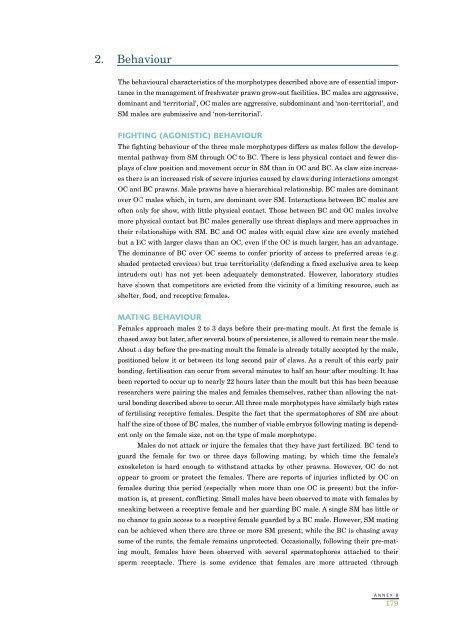Create successful ePaper yourself
Turn your PDF publications into a flip-book with our unique Google optimized e-Paper software.
2. BehaviourThe behavioural characteristics of the morphotypes described above are of essential importancein the management of <strong>freshwater</strong> prawn grow-out facilities. BC males are aggressive,dominant and ‘territorial’, OC males are aggressive, subdominant and ‘non-territorial’, andSM males are submissive and ‘non-territorial’.FIGHTING (AGONISTIC) BEHAVIOURThe fighting behaviour of the three male morphotypes differs as males follow the developmentalpathway from SM through OC to BC. There is less physical contact and fewer displaysof claw position and movement occur in SM than in OC and BC. As claw size increasesthere is an increased risk of severe injuries caused by claws during interactions amongstOC and BC <strong>prawns</strong>. Male <strong>prawns</strong> have a hierarchical relationship. BC males are dominantover OC males which, in turn, are dominant over SM. Interactions between BC males areoften only for show, with little physical contact. Those between BC and OC males involvemore physical contact but BC males generally use threat displays and mere approaches intheir relationships with SM. BC and OC males with equal claw size are evenly matchedbut a BC with larger claws than an OC, even if the OC is much larger, has an advantage.The dominance of BC over OC seems to confer priority of access to preferred areas (e.g.shaded protected crevices) but true territoriality (defending a fixed exclusive area to keepintruders out) has not yet been adequately demonstrated. However, laboratory studieshave shown that competitors are evicted from the vicinity of a limiting resource, such asshelter, food, and receptive females.MATING BEHAVIOURFemales approach males 2 to 3 days before their pre-mating moult. At first the female ischased away but later, after several hours of persistence, is allowed to remain near the male.About a day before the pre-mating moult the female is already totally accepted by the male,positioned below it or between its long second pair of claws. As a result of this early pairbonding, fertilisation can occur from several minutes to half an hour after moulting. It hasbeen reported to occur up to nearly 22 hours later than the moult but this has been becauseresearchers were pairing the males and females themselves, rather than allowing the naturalbonding described above to occur. All three male morphotypes have similarly high ratesof fertilising receptive females. Despite the fact that the spermatophores of SM are abouthalf the size of those of BC males, the number of viable embryos following mating is dependentonly on the female size, not on the type of male morphotype.Males do not attack or injure the females that they have just fertilized. BC tend toguard the female for two or three days following mating, by which time the female’sexoskeleton is hard enough to withstand attacks by other <strong>prawns</strong>. However, OC do notappear to groom or protect the females. There are reports of injuries inflicted by OC onfemales during this period (especially when more than one OC is present) but the informationis, at present, conflicting. Small males have been observed to mate with females bysneaking between a receptive female and her guarding BC male. A single SM has little orno chance to gain access to a receptive female guarded by a BC male. However, SM matingcan be achieved when there are three or more SM present; while the BC is chasing awaysome of the runts, the female remains unprotected. Occasionally, following their pre-matingmoult, females have been observed with several spermatophores attached to theirsperm receptacle. There is some evidence that females are more attracted (throughANNEX 8179
















